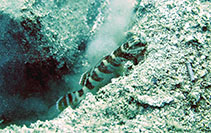| Family: |
Gobiidae (Gobies), subfamily: Gobiinae |
| Max. size: |
13.2 cm TL (male/unsexed) |
| Environment: |
demersal; marine; depth range 6 - 25 m |
| Distribution: |
Indo-West Pacific: Persian Gulf and Reunion to Indonesia and the Philippines, north to southern Japan. |
| Diagnosis: |
Dorsal spines (total): 6-7; Dorsal soft rays (total): 10-10; Anal spines: 1-1; Anal soft rays: 9-9. Characterized by white body color; six ventrally tapered , brown bars/saddles, head with yellow spots; presence of pale-edged black spot at base of first dorsal fin between first and third spine; orange-brown spots on soft dorsal and upper part of caudal fin; anal fin and lower lobe of caudal fin with blue streaks; all dorsal fins filamentous except last spine of first dorsal fin; united pelvic fins, frenum present; longitudinal scale series 80-101; head without scales; greatest depth of body 5.8-6.3 in SL; oblong or rounded caudal fin, longer than head length (Ref. 90102). |
| Biology: |
Found in fine silt bottoms of coastal reefs in 6-25 m (Ref 90102). |
| IUCN Red List Status: |
Least Concern (LC); Date assessed: 19 June 2017 Ref. (130435)
|
| Threat to humans: |
harmless |
Source and more info: www.fishbase.org. For personal, classroom, and other internal use only. Not for publication.

